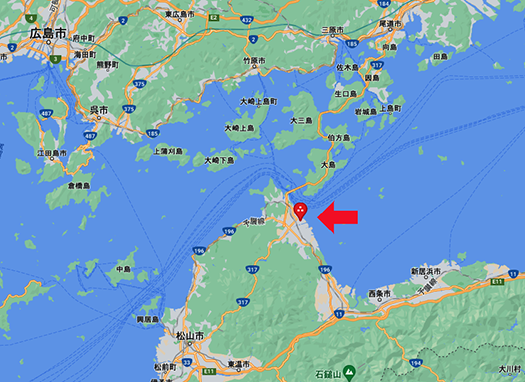


日本の城郭で基礎的な技術は「石垣」の積層技術なのでしょう。
自然地形を活かしベースにしながら、具体的な戦争行為をそこに反映させて
防御的な視点から陣地を構築して行くとき、
「攻め手が諦める」高い石垣というのが基本だと思われる。
一定の高さ以上の石積みには高い技術発展があったとされる。
そしてもう一つは、濠という水での防衛ということ。
刀や矢、鉄砲による攻撃から身を守るためには防具を着込む必要があり、
それを多人数で装備して濠を越えるのはほぼムリ。
そうして攻城側の陣立てを高い位置から把握して効果的な防衛作戦を組み立てる。
城というのはそういった役割を果たしていたのでしょう。
そういう武力を涵養するには当然ながら経済を押さえる必要があり、
秀吉の大阪城のように全国の富を集中させることで
経済と軍事の主導権を掌握することで日本の歴史的武権は強化された。
そういうことでその両面から日本の土木建築技術が発展した。
上の写真はシリーズで研究している藤堂高虎の築いた「今治城」。
戦略的な位置関係では、歴史的に日本の物流にとって最重要だった
瀬戸内海水運の要衝地に当たることがあきらかです。
地図上の青いラインが現代の「航路」に相当するほどに
理に適った地理把握なのだと思われる。
この要衝地に水運の交易接点としての利便性を高いレベルで確保している。
濠と石垣、そして高所からの人流把握が可能である様子が自明。
日本は多くの山岳によって平野部が分散的になっている。
そして基本が稲作農業であり田んぼに用水を導く土木技術が大発展した。
その土木技術がこの高石垣構築には反映しているのでしょう。
石垣を高く積み上げるには作業合理性と堅牢性の両方が解決される必要がある。
藤堂高虎の時代、水城の土木工事築城手法が大発展して
それをコントロールする技術力が武権側から要請された。
きのうみた近江の琵琶湖水運と陸上交通の結節点を支配する「膳所城」築城で
水上での土木工事技術を確立させ、引き続き瀬戸内海地域で
こうした直接に水運を掌握する水城としての建設も成功させている。
3番目の写真は東国から京都への陸路の要衝、伊賀上野城の高石垣の様子。
どうもこういう石垣構築技術というのが安藤忠雄のコンクリート打ち放しと
二重写しになる気分。藤堂高虎は戦国期の安藤忠雄ともイメージできる(笑)。
いわば土木工事技術によって建築意思を持って地形を改造し、
それを強固な壁としてコンクリートする、みたいな同質性を感じるのです。
逆に現代の「作家性」の高まった建築家たちが、もし築城という建築機会を得たら
どういう城郭建築を実現させるのかと、妄想する(笑)。
日本人というのはこういう築城、自然改造による建築意思の表現が
民族的に相当に「数寄」なのではないかと思ってきています。さて・・・。
English version⬇
The History of the Remodeling of the Archipelago through the Construction of Stone Walls and Waterways – Exploration of Nara and Wakayama – 28
The history of DNA is deeply engraved in the architecture of castles. …
The fundamental technology in Japanese castles is probably the “stone wall” lamination technique.
While utilizing and veiling the natural terrain, specific acts of war are reflected in it.
When building a position from a defensive point of view
It seems to me that the basic idea is a high stone wall that “the attacker gives up.
It is said that there was a high level of technological development in masonry above a certain height.
The other is the defense by water called moat.
In order to protect themselves from attacks by swords, arrows, and guns, it was necessary to wear protective gear.
It was almost impossible for a large number of people to cross the moat equipped with such gear.
The castle was thus used to grasp the position of the attackers from a high vantage point and to formulate an effective defensive strategy.
This is the role of a castle.
In order to cultivate such military power, it was of course necessary to control the economy.
By concentrating the wealth of the whole country, as in Hideyoshi’s Osaka Castle
By seizing control of the economy and the military, Japan’s historical military power was strengthened.
That is how Japan’s civil engineering and construction technology developed on both fronts.
The photo above is “Imabari Castle” built by Takatora Todo, whom we are studying in the series.
In terms of strategic location, it was historically the most important for Japanese logistics.
It is clear that Imabari Castle is located at the strategic point of the Seto Inland Sea water transportation, which was historically the most important for the distribution of goods in Japan.
The blue line on the map corresponds to a modern-day “sea route.
The blue line on the map corresponds to a modern “sea route.
The site is conveniently located at this strategic point as a trading contact point for water transportation.
The moat, stone walls, and the ability to grasp the flow of people from high places are self-evident.
In Japan, plains are dispersed by many mountains.
The basic agriculture in Japan is rice farming, and civil engineering technology to guide water to rice paddies has developed greatly.
This civil engineering technology is probably reflected in the construction of this high stone wall.
In order to pile up stonewalls high, both work rationality and robustness need to be resolved.
During the reign of Takatora Todo, the method of civil engineering construction of water castles developed greatly, and
The technical ability to control it was required from the military side.
The construction of “Zesho Castle,” which controlled the node of Lake Biwa water transportation and land transportation in Omi, as I mentioned yesterday, established the technology of civil engineering works on the water.
The castle was built to control the water transportation of Lake Biwa and land transportation in the Omi area, and the construction of Zessho Castle established civil engineering technology on the water.
The third photo shows a castle built in the Seto Inland Sea area in Kyoto, which was constructed by the shoguns from the eastern part of the country.
The third photo shows the high stonewalls of Iga-Ueno Castle, a strategic point on the overland route from Higashikuni to Kyoto.
This kind of stone wall construction technique is a double image of Tadao Ando’s concrete wall.
I feel like I am in a double vision of Tadao Ando’s concrete wall construction techniques. I can imagine Takatora Todo as Tadao Ando of the Sengoku period (laugh).
In a manner of speaking, he modified the terrain with architectural intent through civil engineering technology, and then concreted it as a solid wall.
I feel a sense of homogeneity, like a person who transforms the terrain with architectural intent through civil engineering techniques and concretes it as a solid wall.
On the other hand, if contemporary architects with a heightened sense of “auteurism” were given the opportunity to build a castle, what kind of castle architecture would they realize?
I fantasize about what kind of castle architecture they would create if they had the opportunity to build a castle (laughs).
Japanese people have a strong tendency to express their architectural intentions through castle construction and natural remodeling.
I am beginning to think that the Japanese are quite “sukiyoshi” in terms of their ethnicity. Now…
Posted on 5月 16th, 2022 by 三木 奎吾
Filed under: 住宅マーケティング, 歴史探訪







コメントを投稿
「※誹謗中傷や、悪意のある書き込み、営利目的などのコメントを防ぐために、投稿された全てのコメントは一時的に保留されますのでご了承ください。」
You must be logged in to post a comment.